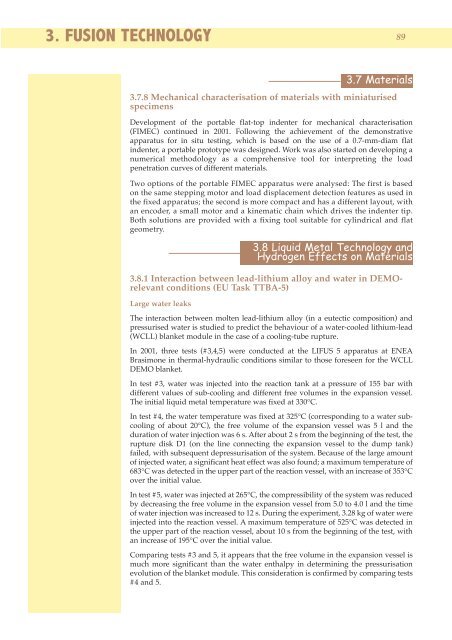1. magnetic confinement - ENEA - Fusione
1. magnetic confinement - ENEA - Fusione
1. magnetic confinement - ENEA - Fusione
You also want an ePaper? Increase the reach of your titles
YUMPU automatically turns print PDFs into web optimized ePapers that Google loves.
3. FUSION TECHNOLOGY 89<br />
3.7.8 Mechanical characterisation of materials with miniaturised<br />
specimens<br />
Development of the portable flat-top indenter for mechanical characterisation<br />
(FIMEC) continued in 200<strong>1.</strong> Following the achievement of the demonstrative<br />
apparatus for in situ testing, which is based on the use of a 0.7-mm-diam flat<br />
indenter, a portable prototype was designed. Work was also started on developing a<br />
numerical methodology as a comprehensive tool for interpreting the load<br />
penetration curves of different materials.<br />
Two options of the portable FIMEC apparatus were analysed: The first is based<br />
on the same stepping motor and load displacement detection features as used in<br />
the fixed apparatus; the second is more compact and has a different layout, with<br />
an encoder, a small motor and a kinematic chain which drives the indenter tip.<br />
Both solutions are provided with a fixing tool suitable for cylindrical and flat<br />
geometry.<br />
3.8.1 Interaction between lead-lithium alloy and water in DEMOrelevant<br />
conditions (EU Task TTBA-5)<br />
Large water leaks<br />
3.7 Materials<br />
3.8 Liquid Metal Technology and<br />
Hydrogen Effects on Materials<br />
The interaction between molten lead-lithium alloy (in a eutectic composition) and<br />
pressurised water is studied to predict the behaviour of a water-cooled lithium-lead<br />
(WCLL) blanket module in the case of a cooling-tube rupture.<br />
In 2001, three tests (#3,4,5) were conducted at the LIFUS 5 apparatus at <strong>ENEA</strong><br />
Brasimone in thermal-hydraulic conditions similar to those foreseen for the WCLL<br />
DEMO blanket.<br />
In test #3, water was injected into the reaction tank at a pressure of 155 bar with<br />
different values of sub-cooling and different free volumes in the expansion vessel.<br />
The initial liquid metal temperature was fixed at 330°C.<br />
In test #4, the water temperature was fixed at 325°C (corresponding to a water subcooling<br />
of about 20°C), the free volume of the expansion vessel was 5 l and the<br />
duration of water injection was 6 s. After about 2 s from the beginning of the test, the<br />
rupture disk D1 (on the line connecting the expansion vessel to the dump tank)<br />
failed, with subsequent depressurisation of the system. Because of the large amount<br />
of injected water, a significant heat effect was also found; a maximum temperature of<br />
683°C was detected in the upper part of the reaction vessel, with an increase of 353°C<br />
over the initial value.<br />
In test #5, water was injected at 265°C, the compressibility of the system was reduced<br />
by decreasing the free volume in the expansion vessel from 5.0 to 4.0 l and the time<br />
of water injection was increased to 12 s. During the experiment, 3.28 kg of water were<br />
injected into the reaction vessel. A maximum temperature of 525°C was detected in<br />
the upper part of the reaction vessel, about 10 s from the beginning of the test, with<br />
an increase of 195°C over the initial value.<br />
Comparing tests #3 and 5, it appears that the free volume in the expansion vessel is<br />
much more significant than the water enthalpy in determining the pressurisation<br />
evolution of the blanket module. This consideration is confirmed by comparing tests<br />
#4 and 5.













